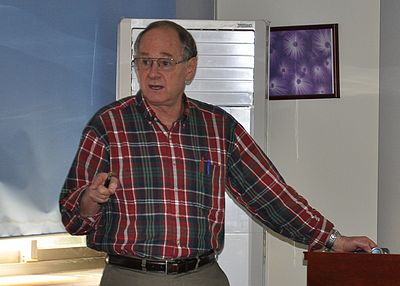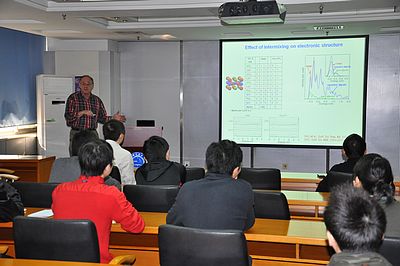美国Pacific Northwest National Laboratory的Prof. Scott A. Chambers前来实验室进行学术交流与访问
- 时间:2011-11-11 02:10:33 来源:合肥微尺度物质科学国家实验室|http://www.hfnl.ustc.edu.cn


Complex oxides exhibit a rich array of properties as a result of the degrees of freedom that can be achieved by the choice of metal cations. This richness has been built upon by preparing interfaces of dissimilar perovskites. One of the most interesting and widely investigated systems of this kind is the LaAlO3/SrTiO3(001) (LAO/STO) heterojunction. Despite the fact that both materials are band insulators, their interface can exhibit electronic conductivity. These results have been widely interpreted as being due to an electronic reconstruction (or charge transfer) resulting from the polarity mismatch between LAO and STO, giving rise to a two-dimensional electron gas on the STO side of the interface. However, it is also known that this interface exhibits significant cation mixing, and certain intermixed configurations have been shown theoretically to eliminate the interface dipole, in addition to inducing conductivity by unintentional La doping of the underlying STO.
Inasmuch as the LAO/STO interface has been very heavily studied, it is of interest to explore other related materials systems. To this end, we have investigated the LaCrO3/SrTiO3(001) (LCO/STO) heterojunction, as prepared by molecular beam epitaxy. Core-level and valence-band x-ray photoemission spectra yield band offsets and potential gradients within the LaCrO3 sufficient to trigger an electronic reconstruction to alleviate the polarity mismatch. Yet, the interface is insulating. Based on first principles calculations, we attribute this unexpected result to interfacial cation mixing combined with charge redistribution within CrO2 layers, enabled by low-lying d states within LaCrO3, which suppresses.
相关文章
- 上海纽约大学Prof. CHEN Hanghui来研究中心进行学术交流与访问2018-12-25 02:31:15
- 瑞士保罗谢尔联邦研究所史明研究员来研究中心进行学术交流与访问2018-12-21 07:48:23
- 复旦大学晏湖根教授来研究中心进行学术交流与访问2018-12-17 02:33:42
- 苏州大学胡军教授来研究中心进行学术交流与访问2018-12-14 07:49:45
- 安徽大学葛炳辉教授来研究中心进行学术交流与访问2018-12-14 07:39:12
- 同济大学裴艳中教授来研究中心进行学术交流与访问2018-12-14 07:27:28

